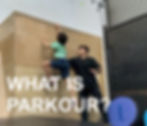What Is Parkour?
- Vortex Freerunning
- Aug 26
- 4 min read
Updated: Sep 3
Parkour is a modern lifestyle sport that uses the environment as a playground to get from point A to point B. Parkour training emphasizes the development of physical movement skills and conditioning to help cultivate a well-rounded athlete by engaging several muscle groups at once while also growing their creative problem-solving skills. The sport involves running, jumping, climbing, vaulting, swinging, and more. The popularity of parkour has grown considerably in the last several years and has turned into a competitive sport, leaving many wondering what parkour actually is.
At Vortex Freerunning, we use parkour as a tool to help children become stronger both mentally and physically. Our specialized programs are designed to help kids push themselves past their limits through focused, hands-on guidance. With classes of all skill levels and ages, we can help your kids enhance their confidence and coordination in an exciting and dynamic way.
To schedule your first class or sign up for a membership, please contact us online.

About Parkour
Parkour is an athletic training discipline and sport that involves jumping, vaulting over obstacles, and climbing in non-dedicated, often urban settings. (Grosprêtre and Lepers 526-535) This sport is often called “the art of movement,” and helps athletes train to see their environment in a new way. The idea of parkour is to get from one point to another in the most efficient way possible by navigating different objects. Those who engage in parkour are known as traceurs and turn normal obstacles, such as walls and railings, into playground features. Instead of going around them, they go over, under, and through them.
Parkour training, however, pushes more than just athleticism, but also mental strength. Parkour is also about overcoming self-fear and doubt, allowing traceurs to push themselves farther than they think they can. Instead of going straight for the biggest jump, traceurs train in incremental steps, building up their abilities and focusing on the progress made. This allows them to learn how to assess an environment, break down new challenges, and commit to their actions with confidence.
The Benefits of Practicing Parkour
There are several key benefits to practicing parkour. The sport works out the full body, engaging muscles in the core, legs, and upper body while improving cardiovascular health. Parkour also offers mental benefits. Through practice and training, traceurs can sharpen their problem-solving skills and increase their overall confidence by managing and facing their fears. Training alongside others can also foster a sense of community and belonging, connecting them with others who can help push them to be the best version of themselves.
Additional benefits include:
Improved balance, agility, coordination, stamina, and physical awareness.
Enhanced mental focus and stress management.
Improves self-esteem and confidence by overcoming physical and mental obstacles.
Development of versatile skills that can translate over to other sports and everyday activities.
Opportunities for positive interactions within a welcoming community.
Accessibility to practice in most environments without the need for specialized equipment.
Finding a Parkour Gym in North Hollywood or Thousand Oaks
If you are interested in finding a parkour gym that can push your children past their limits, look no further than Vortex Freerunning. We don’t just teach parkour as a sport, but use it to inspire children and build their sense of self. Our dedicated coaches and trainers provide personalized attention to each individual, offering a one-of-a-kind experience that nourishes both athletic and life skills. Our programs are designed to help children set and reach personal milestones, with each program being tailored to different age groups and skill levels. Additionally, we offer unlimited weekend open gym access, so your child can continue to explore and practice new skills outside of their scheduled classes. Our memberships are more than just weekly sessions, but gateways to personal growth.
If your kid is ready to get started, we invite you to sign up for a free trial class! If you have any questions or want to learn more about our classes, we encourage you to submit our online contact form.
The History of Parkour
David Belle was born in 1973 and is considered the founder of parkour. Growing up, he found himself dissatisfied with the skills he was attaining through gymnastics, school sports clubs, and general athletics. Through conversations with his father, a survivor of the Indochina War and member of the Paris Fire Brigade, he realized he wanted to learn skills that would allow him to navigate through life more easily. (Angel) He learned about the practice of “parcours” through these discussions and decided to dedicate his time to training. He later went on to develop the first parkour group, Yamakasi, but conflicting interests rose between the members as their popularity rose. David chose to leave the group to pursue his own goals, coining the term “parkour” during his exit to describe the activity.
References
Angel, Julie. “Ciné Parkour: A Cinematic and Theoretical Contribution to the Understanding of the Practice of Parkour.” Academia.edu, 2011, https://www.academia.edu/80702824/Cin%C3%A9_Parkour_A_cinematic_and_theoretical_contribution_to_the_understanding_of_the_practice_of_parkour. Accessed 10 Aug. 2025.
Derakhshan, Nima, and Tony Machejefski. “Distinction between Parkour and Freerunning.” Chinese Journal of Traumatology, vol. 18, no. 2, Apr. 2015, p. 124, https://doi.org/10.1016/j.cjtee.2015.07.001. Accessed 10 Aug. 2025.
Grosprêtre, Sidney, and Romuald Lepers. “Performance Characteristics of Parkour Practitioners: Who Are the Traceurs?” European Journal of Sport Science, vol. 16, no. 5, 12 Aug. 2015, pp. 526–535, https://doi.org/10.1080/17461391.2015.1060263. Accessed 10 Aug. 2025.
Wilkinson, Alec. "No Obstacles." The New Yorker, 16 Apr. 2007. Archived from the original on 11 Oct. 2007. Accessed 10 Aug. 2025.
